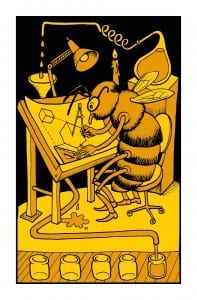Who knew honey could BEE so interesting. Get it? Get it?
By Sarah E M Wiseman, on 19 June 2012
The tent was buzzing. Literally. There was a box of bees sitting on the table on stage. I was at the late night ‘Science of Honey’ talk. Despite being on at the same time as the England-Sweden match, the place was packed.
This event was to be a combination of fascinating bee facts and ridiculous honey experiments. On stage was the experimental comedy duo of Andrea Sella and Mark Miodownik. Experimental in the sense that they had fire, giant molecules and a charging wand on stage. And they made a mess. Complementing this side of things was Daniel Basterfield, keen apiarist and knower of all things bee and honey related.
Daniel began by introducing us to the history of honey and beekeeping. There are cave paintings from 9,000 years ago showing humans taking honey from bees. Beehives provided pollen for protein, wax for fat and, perhaps most importantly, honey for sugar and energy.
It makes sense that, eventually, humans would realise the importance of having bees around and would begin to work with the bees to gain their honey, rather than ransacking hives like their ancestors would have.
 Close
Close

